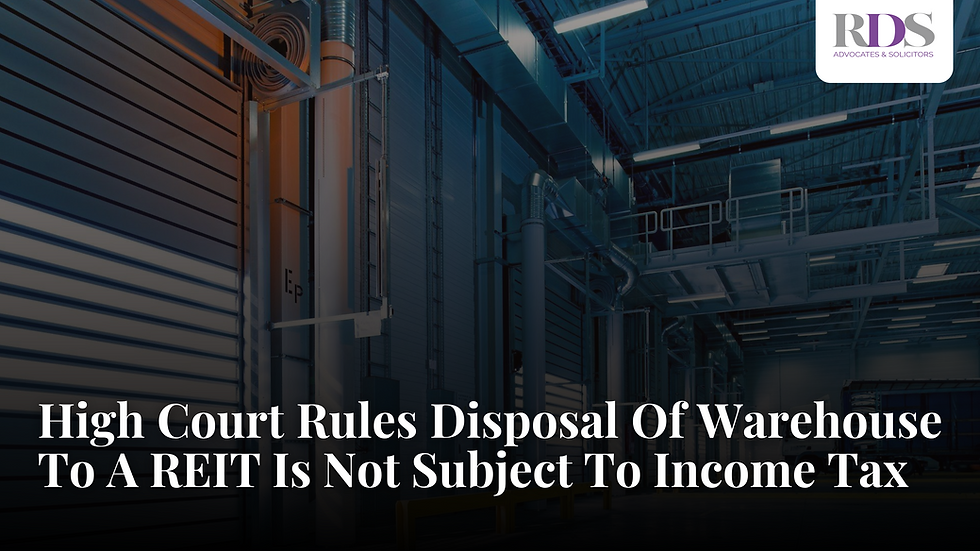High Court Rules Disposal Of Warehouse To A REIT Is Not Subject To Income Tax
- RDS Project
- Aug 11
- 4 min read

Recently, the High Court in Ketua Pengarah Hasil Dalam Negeri v ELSB considered whether the Revenue could impose income tax on the gains arising from the disposal of a warehouse that had already been exempted under the RPGT regime.
The High Court affirmed the decision of the Special Commissioners of Income Tax (SCIT) and found in favour of the taxpayer that the disposal did not give rise to income taxable under the Income Tax Act 1967 (ITA).
The taxpayer in this matter was successfully represented by the firm’s Tax, SST & Customs Partner, S. Saravana Kumar, together with associate, Felicia Wong Sie Ying.
Background Facts
The dispute arose from the taxpayer’s disposal of a warehouse located in Shah Alam. The warehouse, which was empty and untenanted for some time, was acquired by the taxpayer in July 2012 for RM 23.6 million from a real estate investment trust (REIT). The taxpayer undertook some repair and maintenance work to make the warehouse tenantable and was eventually found a multinational company as a long term tenant.
In August 2014, the very same REIT that sold the warehouse to the taxpayer, approached the taxpayer and offered to buy the tenanted warehouse for RM 52.5 million. Moved by the attractive offer price, the taxpayer decided to sell the warehouse back to the REIT.
Following the disposal, the taxpayer took the stance that the gains arising from the disposal of the warehouse was real property gains and submitted real property gains tax (RPGT) return to the Revenue. As the warehouse was sold to a REIT, the taxpayer was entitled to be exempted from RPGT by virtue of the Real Property Gains Tax (Exemption) (No. 4) Order 2003 (Exemption Order), which exempts disposals of chargeable assets to REITs approved by the Securities Commission. Accordingly, the gains arising from the disposal of the warehouse were exempted from RPGT and the Revenue issued a certificate of clearance to the taxpayer.
However, in November 2017, the Revenue changed its mind and without discharging the RPGT certificate of clearance issued earlier, proceeded to raise a notice of additional assessment for income tax and penalty totalling RM 7.23 million. The Revenue claimed that the disposal of the warehouse should have been taxed under the ITA as a gain arising from a trade.
The taxpayer successfully challenged the Revenue’s decision to subject the gains to income tax before the SCIT and the Revenue appealed to the High Court.
The Revenue’s Contention
The Revenue argued that the SCIT had erred in both fact and law as the taxpayer’s dominant intention was always to sell the warehouse at a profit and that the investment label was nothing more than a façade. According to the Revenue, although the warehouse had been rented out for several years, the taxpayer’s decision to dispose of the property upon receiving a favourable offer demonstrated a shift in intention, i.e. from investment to trading.
The Revenue claimed that the object clause in the taxpayer’s memorandum and articles of association was not conclusive. It relied on ALF Properties Sdn Bhd v Ketua Pengarah Hasil Dalam Negeri [2005] 5 MLJ 717 and asserted that the past and present activities of the company must be scrutinised to come to a safe conclusion. The Revenue maintained that the taxpayer had failed to discharge the burden of proving that the gain was capital in nature.
The Taxpayer’s Contention
The taxpayer responded by submitting that the gains do not fall under the ITA.
First, the taxpayer maintained that the sale of the warehouse did not amount to a trading activity as the property had been held as a long-term investment, which was leased to a tenant for a long-term period. The disposal was prompted solely by an unsolicited offer at 22% above market value by the buyer. Further, the taxpayer did not undertake any effort to sell or advertise the warehouse for sale.
The taxpayer also referred to the recent Federal Court decision in Kind Action, which addressed a similar issue of double taxation. In that case, the Federal Court held that the Revenue could not impose income tax on the same transaction without first discharging the RPGT assessments or certificates of clearance, as such conduct would result in unlawful double taxation.
Applying this principle, the taxpayer submitted that the Revenue having accepted the disposal of the warehouse under the RPGT regime by issuing a certificate of clearance and allowing the exemption under the Exemption Order, cannot then attempt to tax the same gain under the ITA without first revoking its earlier position.
Conclusion
The High Court dismissed the Revenue’s appeal and upheld the SCIT’s finding. This ruling reinforces the critical distinction between capital gains and trading income; and emphasises on the procedural discipline required of the Revenue when shifting between tax regimes. Even without explicit reference to Kind Action, this ruling is a strong affirmation of the principle that taxpayers should not be taxed twice on the same gain under separate legislative framework.
The case also provides helpful guidance on how the “badges of trade” are applied in practice. A one-off disposal, made in response to a lucrative unsolicited offer, does not automatically constitute a trading activity. It is hoped that this ruling provides clarification to taxpayers who hold or wish to hold real property for long-term investment purposes.
11 August 2025



